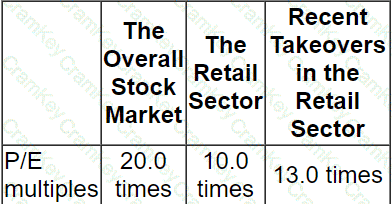| Exam Name: | Financial Strategy | ||
| Exam Code: | F3 Dumps | ||
| Vendor: | CIMA | Certification: | CIMA Strategic |
| Questions: | 393 Q&A's | Shared By: | eisa |
A company is based in Country Y whose functional currency is Y$. It has an investment in Country Z whose functional currency is Z$.
This year the company expects to generate Z$ 10 million profit after tax.
Tax Regime:
• Corporate income tax rate in country Y is 50%
• Corporate income tax rate in country Z is 20%
• Full double tax relief is available
Assume an exchange rate of Y$ 1 = Z$ 5.
What is the expected profit after tax in Y$ if the Z$ profit is remitted to Country Y?
Company T is a listed company in the retail sector.
Its current profit before interest and taxation is $5 million.
This level of profit is forecast to be maintainable in future.
Company T has a 10% corporate bond in issue with a nominal value of $10 million.
This currently trades at 90% of its nominal value.
Corporate tax is paid at 20%.
The following information is available:

Which of the following is a reasonable expectation of the equity value in the event of an attempted takeover?
G purchased a put option that grants the right to cap the interest on a loan at 10.0%. Simultaneously, G sold a call option that grants the holder the benefits of any decrease if interest rates fall below 8.5%.
Which THREE possible explanations would be consistent with G's behavior?
A company is currently all-equity financed with a cost of equity of 9%.
It plans to raise debt with a pre-tax cost of 3% in order to buy back equity shares.
After the buy-back, the debt-to-equity ratio at market values will be 1 to 2.
The corporate income tax rate is 25%.
Which of the following represents the company's cost of equity after the buy-back according to Modigliani and Miller's Theory of Capital Structure with taxes?